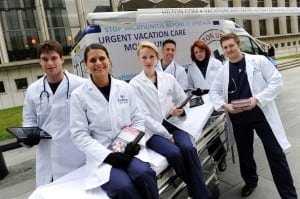
An ever-increasing amount of work is being piled onto the desks of the world’s workers, making it more and more diffi- cult to simply take a break from the grind. Even when people go on vacation, studies show, they are checking work email regu- larly and feeling work-related stress.
Hilton Hotels & Resorts execs have seen all those studies, too. And while the brand has benefited from plenty of loyal professionals who need a reliable place to stay while traveling for work, the hotel chain wanted to find a way to help those same pressed-for-time individuals see that Hilton could provide an escape, as well.
Since the first quarter is traditionally the weakest travel period, the aim was to turn on the PR push during that period and convince consumers that taking a break could be good for them (not to mention for Hilton’s top and bottom lines).
In addition to driving incremental leisure revenue in the first quarter, Hilton also wanted to accomplish the following:
- Drive “Any Weekend, Anywhere” business.
- Increase awareness of brand leisure offerings and wider association with leisure, particularly among working professionals in the U.S., U.K., and Latin America.
- Fuel enrollment to the Hilton VIP Newsletter.
- Strengthen brand engagement and grow audience.
HUMOR HELPS
The main tool to make it all happen? Humor. Hilton and its partner, Murphy O’Brien Public Relations, built the campaign around the concept of “Vacationitis” and its many strains, such as “Interpersonal Drone Disorder” or “Commuteritis.”
To take that desired young-professional demo by surprise, Hilton and Murphy O’Brien created a funny campaign that featured the tongue-in-cheek interactive microsite Hilton Urgent Vacation Care Center. The site, which launched in mid-January, includes a vacation diagnostic test that determines just how “sick” site visitors are and gives them custom prescriptions that just happen to involve stays at Hilton hotels.
“In order to seize their attention, we knew we needed to make a big statement that aligned with the zeitgeist of today while providing real value and incentives,” says Allyson Rener, president of Murphy O’Brien.
The results of the site’s online test fed a real-time interactive map on the site that showcased the “Global Vacation Alert Level” of various locales.
It also featured a so-called “recovery room,” where consumers could find special travel deals. Traffic to the site was also spurred by Hilton giving away 15 free vacations. That alone collected more than 17,000 entries.
“What better way to increase (working professionals’) awareness of the brand’s incredible leisure-travel offerings than with playful and somewhat bold workforce humor?” Rener says.
She added: “We introduced the Vacationitis campaign to attract and engage this important demographic while giving consumers a peek into the brand’s leisure offerings in a way that was funny and entirely unexpected.”
One of the most effective parts of the campaign featured shareable memes from humor powerhouse Onion Labs, the year-old creative arm of the satirical newspaper, The Onion, that’s worked with such brands as EA Games, Microsoft and Orbitz.
“We realized that we needed to capture people’s attention at the onset and find a way to make a significant, lasting connection with the target audience of working professionals,” said John Forrest Ales, senior director, Global Brand Public Relations at Hilton Hotels & Resorts.
He adds: “Since The Onion is a leading and globally respected satirical news outlet with a readership in sync with our target, we had no doubt that its creative services division was the perfect partner to create statement-worthy cartoon memes that would build buzz, prompt lots of laughs and let consumers know we understand them and have real solutions.”
GLOBAL REACH
Hilton saw strong engagement with the campaign across the Americas, Europe, the Middle East, Africa and Asia Pacific, and offered human-translated content in Spanish and Portuguese.
For Europe’s “Blue Monday,” the third Monday in January, which has been deemed the most depressing day of the year there, Hilton created a “pop-up beach” on the River Thames, inviting passersby to experience a “mini-vacation.”
The jaunt featured a short run around in the sand with seven models in swimsuits, who were playing with beach balls and braving low temps to help aid the promotion.
PR efforts like the “mini-vacation” and the involvement of The Onion helped Hilton secure more than 100 media placements in North America, the U.K. and Latin America, including feature stores in International Herald Tribune and The New York Times, for a total audience reach of nearly 300 million.
FUNNY BONES
The newsletter is an “important revenue driver and is distributed to hundreds of thousands of subscribers each week by email,” Ales says.
Newsletter subscribers are driven directly to booking rooms on Hilton.com. “In Europe, the Middle East and Africa, it was the most clicked on promotion since the newsletter has been distributed this year,” Ales adds.
Other results of the Vacationitis campaign included:
- 50,555 overall visits to the website.
- 19,500 visitors completed the quiz.
- 17,415 entrants to the “Cure Vacationitis with Hilton” sweepstakes (during the sweepstakes period of January 14 to February 28).
- 34,816 visits to Hilton.com.
- More than 20,000 shares, comments and “likes” on Vacationitis Facebook posts to drive engagement.
The effort also was a part of a social-media blitz that helped Hilton Hotels & Resorts grow its Facebook “likes,” from roughly 500,000 in January, to more than one million.
Before January, its Facebook posts were mostly images of its properties and the nearby beaches. It shifted gears to showcase travel tips and news, such as that when the first cellphone call was made (in 1973) it was made in front of a Hilton hotel.
That kind of new attitude meshed well with the offbeat energy of the Hilton Urgent Vacation Care Center. That reinvention is paying off for the brand. Hilton Hotels won’t release how many actual bookings were generated by the PR effort, but Rener says that the campaign “has exceeded all our expectations.”
Of course, it also got Hilton a sickness that likely can’t be cured. “Building from this momentum, we can’t wait to launch initiatives this summer for the ongoing Vacationitis campaign,” Rener says. “Our agency partners in the U.K. led two consumer-facing events in April featuring a mobile Vacation Care Unit and we will be announcing additional exciting U.S. activity later in” the third quarter.
You can call however many doctors you want. It looks like Vacationitis may be here to stay for a while. PRN
CONTACT:
John Forrest Ales, @JFAtweets; Allyson Rener, @1allysonrener.
3 PR Tips for Sparking Creative Partnerships

Hilton Hotels & Resorts had a solid history of serving professionals as they traveled on business trips. But the brand wanted business professionals to see see the brand in a new light: as an escape from work and a perfect place for a getaway. Allyson Rener, president of Murphy O’Brien Public Relations, shares how the brand made that happen.
- Maintain your role through consistency: From initial partner discussions to the conceptual and production phases, reinforce your role as an active partner in the creative process. This can be accomplished by establishing consistency for your brand’s key elements; in Hilton’s case this ranged from check-in calls and brainstorm sessions to creative content submissions and campaign reviews.
- Draw Inspiration from real life, real time: Think about what people are buzzing about and what is trending online, such as the content that appears across Facebook news feeds and Twitter pages, ideas and references and trends that are actively shaping the culture. Work together to leverage something so you can connect with consumers in a meaningful way.
- Keep content king: Just as good design never has form without function, remember throughout the collaboration that creative campaigns can’t soar if the content is weak, inconsistent or lacking real relevance, no matter how good it may look or be executed.
